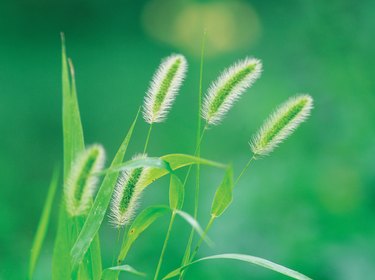
Foxtails (Setaria spp.) have bushy, seed-filled flower heads that captivate children and birds, but these grassy weeds don't charm turf enthusiasts. The plants' wide leaf blades stand out among finer turf grasses long before the flowering plumes appear. Foxtail plants live only one year, but heavy seed production can keep them coming back. Prevention coupled with control can help you banish foxtails from your lawn grass.
Understanding the Opposition
Video of the Day
Foxtail species are different sizes, from the 3-foot-tall green foxtail (Setaria viridis) to the 6 1/2-foot-tall giant foxtail (Setaria macrocarpa). Even so, all share the same life cycle. As true annuals, foxtails germinate, grow, produce seeds and die in the course of a single year. Many foxtail species drop their seeds in fall, and their seeds germinate in spring. Some foxtail seeds, though, germinate as soon as they mature and hit the ground; they can germinate from late spring into fall. Given a sunny lawn, foxtails outcompete weaker plants. A single foxtail plant can produce thousands of seeds during one summer.
Video of the Day
Using Cultural Controls
Manual intervention deters young foxtails from easing into a lawn. Prevent them from producing and maturing seeds to avoid additional foxtail plants. A foxtail's shallow, fibrous root system pulls easily from moist soil. Hand-pulling foxtails is an effective control method for them. Loosen a plant's root with a dandelion-weeder tool, and then give the plant a firm, upward yank. Let the removed plant dry in the sunlight to be sure it won't come back. Before foxtails' seeds mature, cutting them off the stems either manually or with a lawn mower limits the plants' seed production and germination. Dense, healthy turfgrass blocks the sunlight that fallen foxtail seeds need to germinate.
Preventing New Foxtails
A benefin-based, selective pre-emergent herbicide prevents newly germinated foxtail seeds from developing root systems. Such an herbicide works only when applied before the seedlings emerge. Because the product breaks down quickly at high temperatures, cool-season applications work best. Apply the herbicide uniformly across your lawn at times and rates appropriate for your growing region; check the product's label for the correct application rate and timing for your lawn's type of turf. For cool-season, northern turf grasses, for example, apply 1.38 pounds of a benefin-based herbicide per 1,000 square feet of lawn in early spring. For warm-season, southern turf grasses, apply 1.83 to 2.75 pounds of the herbicide per 1,000 square feet of lawn in late winter or early spring. Water a site immediately after treating it with herbicide.
Managing Emerged Weeds
As a last resort, turn to a post-emergent herbicide. Because foxtails are grasses, many post-emergent herbicides designed to kill foxtails damage turf grasses as well. Check your product's label carefully to ensure the herbicide won't harm your lawn, and apply the product with precision. The greater a plant's leaf surface, the more impact herbicide has on the plant. Wait a few days after treating foxtails to mow your lawn. A post-emergent herbicide may require multiple applications. Repeat applications whenever new foxtail seeds germinate. A ready-to-use, fenoxaprop-p-ethyl-based herbicide kills mature foxtails and can be used in lawns with cool-season grasses but not in lawns with warm-season grasses. A spray of standard, household, 5-percent vinegar kills foxtail weeds fewer than 2 weeks old. Spray the foxtails thoroughly with either the herbicide or vinegar on a day when rain is not in the forecast and no wind is present.
Wear a long-sleeved shirt, long pants, socks, closed-toe shoes, a mask over your nose and mouth, gloves and safety glasses or goggles when mixing and applying any form of pre- or post-emergent herbicide, including vinegar.
- The National Gardening Association: Weed Library -- Foxtail
- Colorado State University, Denver County Extension: Foxtail -- Setaria Spp.
- Ohio State University Extension: Annual Grass Weed Control in Home Lawns
- Colorado State University Extension: Control of Annual Grassy Weeds in Lawns
- U.S. Department of Agriculture: Spray Weeds with Vinegar?
- California Department of Food and Agriculture: Setaria Genus